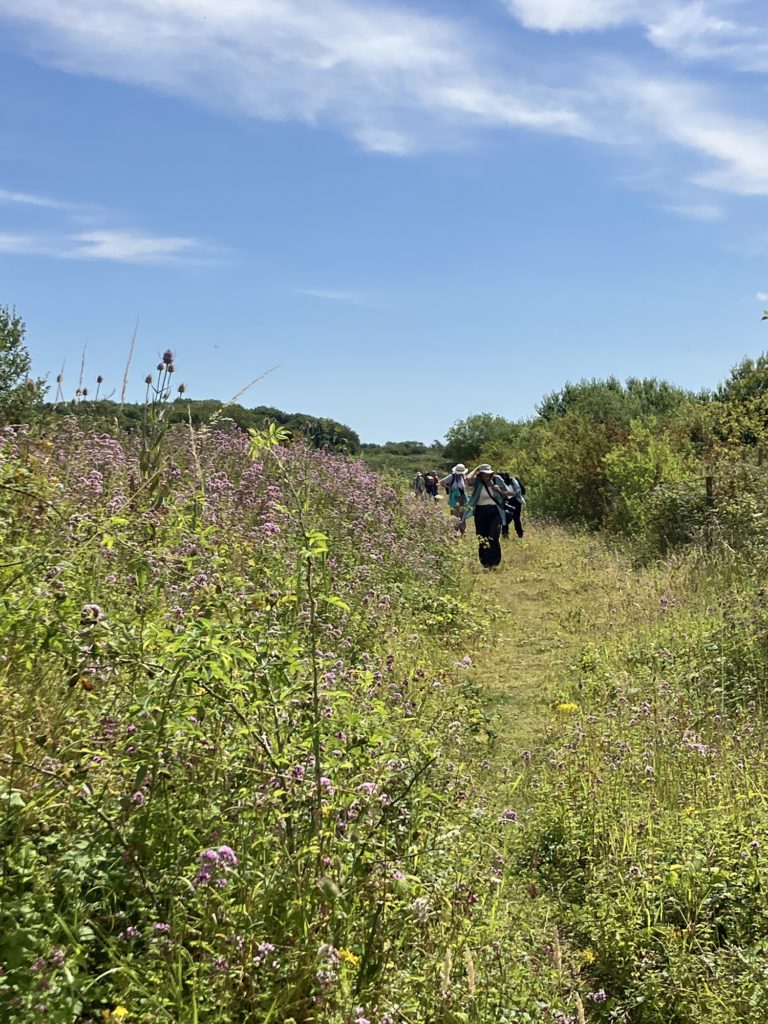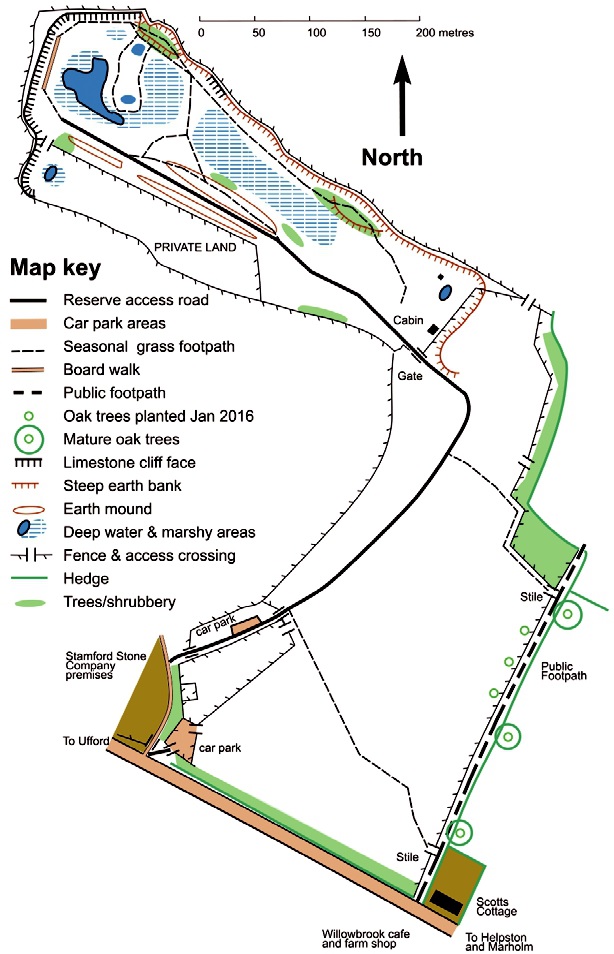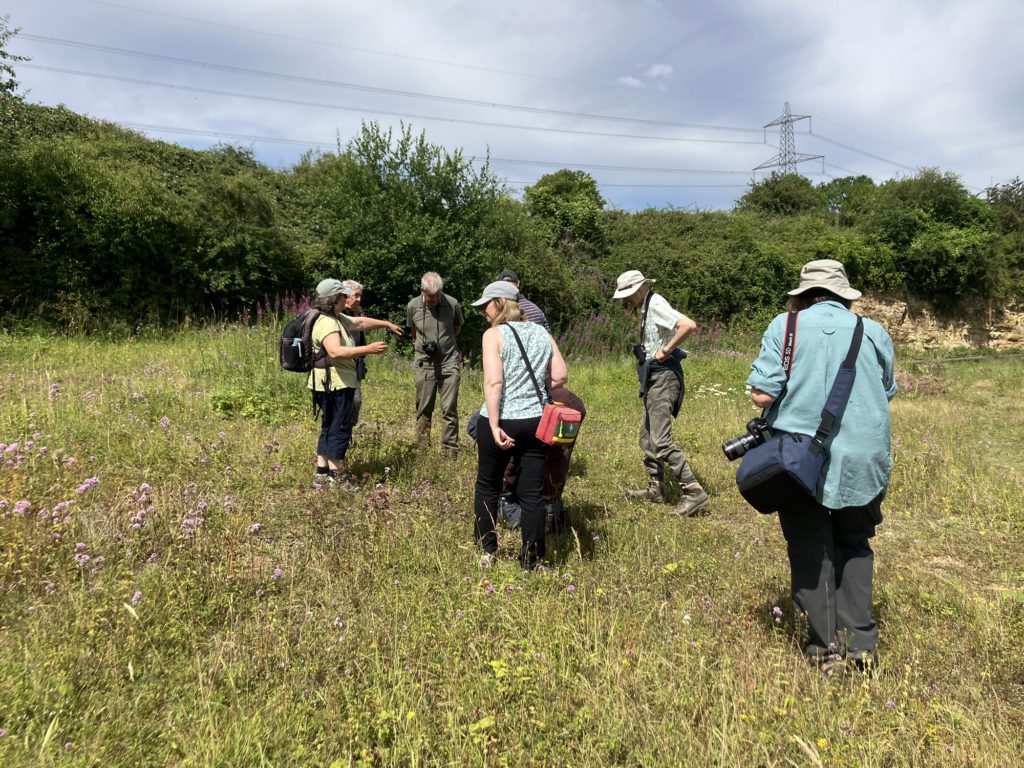Swaddywell Pits (Langdyke Trust NR)- Sunday 21st July 2024

It was a pleasantly warm and dry morning as 18 members and friends assembled at the entrance car park at Swaddywell, between Ufford and Maxey on the Peterborough side of Stamford. The spaces were at a premium, and it was great to see so many members interested in this reserve, with its many and varied flora due to its chequered history. Part of the area was once a quarry, and some of it was used as a rubbish dump. Another area had been home to the VW enthusiasts club, who had tarmacked a roadway into the far end of the reserve.
Our leader for the visit was Sarah Lambert, who many of us knew from her talk earlier this year, on nature in Clare country and the Langdyke Trust owners of Swaddywell. Sarah is an excellent botanist and photographer, trustee of the trust and is a BSBI recorder.

Map of Swaddywell Pits nature reserve
She led us from the car park into the first part of the reserve, which was built on the rubbish tip. It was alive with insects, and covered in wild flowers, centaury, pyramidal orchids, yellow wort, agrimony, self heal, and many others including wild parsnip, the sap of which we were warned can cause non-allergic dermatitis. A hobby was seen and then a kestrel and a kite as we first entered the reserve. We spent quite a lot of time in this area, but slowly made our way diagonally across to the public footpath,where we were intrigued to see the lesser centaury, with its tiny bright pink flowers, like little stars hiding in the bottom of the sward. Another tiny delicate flower was fairy or purging flax, Latin name Linum (flax) catharticum (you can imagine the reason for this unforgettable Latin name!) Sarah gave us a really good, guided tour around the reserve, mentioning the history of the area, as well as pointing out the fascinating flora of the reserve as we walked.
As we followed the pathway into the lower part of the reserve, we saw hemp agrimony and ragwort at the side of our path, both of which are very attractive to bees and insects of many kinds, and here we saw gatekeeper, brimstone and skipper butterflies. Tufted vetch with its bright purple pea type flowers in clusters up the stem was found, and cinnabar moths flying over the tall vegetation. We also found the remains of Man orchid standing up against a fence. A blackcap was heard calling its metallic chip chip as our group entered the lowest part of the reserve. The lake is bounded by a cliff on its northeastern edge, and up on its ledges grew ploughman’s spikenard, a widespread but uncommon plant, named after an aromatic Himalayan oil which was supposedly hung in the homes of ploughmen to sweeten the air. A large specimen of hoary mullein, also perched on the cliff, overlooked the reeds around the margins of the now dried up basin, where we saw sedge with serrated edges to its leaves, clustered stonewort and water mint are also found. Sedge warblers were heard with their repetitive tractor like sound on several occasions in the reedbeds. Gypsywort was another plant that was spotted as we followed the boardwalk around the perimeter of the reserve, and up onto a raised area looking over the reserve. Here ivy bees were busy on the nearby plants, and a buzzard was soaring overhead. The only mammal seen was a dead common shrew picked up along the footpath, and evidence of rabbits in the form of droppings and scrapings at several different points.

Some of our members had shortened the walk and were resting on chairs in front of the cabin and looking out at the lovely summer flowers, listening to the occasional chiff chaff, linnet and at one point a green woodpecker yaffling. They watched the swallows looping and turning overhead. The rest of us descended from the higher area and made our way back to the cabin to rejoin our fellow members to wander back to the car park and make our way home.
A huge thank you to the Langdyke Trust for making us welcome, Sarah Lambert for her expert guidance, and also Claire Noble the Trust’s event coordinator, who came along in support, (and I think also provided drinks to some of us!) We all had a very good visit and hope to return soon.
The full species list will be available on the website.